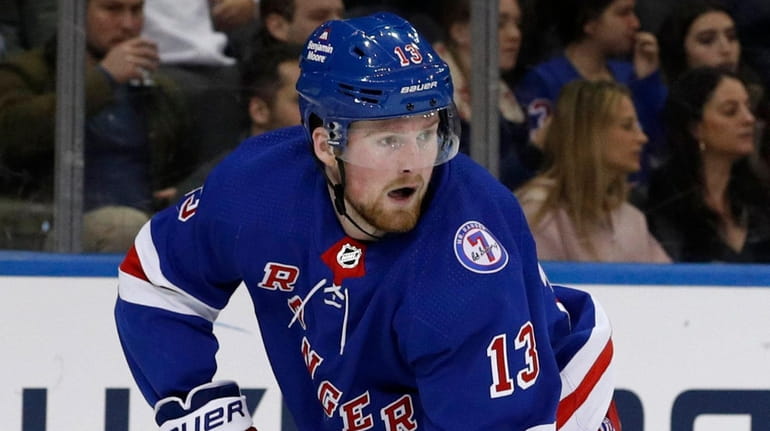Rangers need more secondary scoring to become an elite team

Alexis Lafreniere #13 of the Rangers skates with the puck during the third period against the San Jose Sharks at Madison Square Garden on Friday, Dec. 3, 2021. Credit: Jim McIsaac
It seems obvious that for a team to be the best it can be, its best players have to be the best they can be. And for most of this season, the Rangers’ best players have done that.
Chris Kreider entered Saturday’s off day with the most goals of any player in the NHL. Goaltender Igor Shesterkin led the league (counting goalies who had played in at least half of their team’s games) in save percentage (.936) and was second in goals-against average (2.10). Adam Fox, currently on injured reserve with an upper-body injury, led all defensemen in scoring (47 points), and Artemi Panarin, Fox, Kreider and Mika Zibanejad were in the top 20 in scoring.
But for a team to get to the next level, its second-tier players must produce, too. And when it comes to evaluating the Rangers and deciding whether they belong in the NHL’s elite teams category, that’s where the question marks are.
Barclay Goodrow’s recent surge — he’s scored in three straight games while playing right wing on the Panarin-Ryan Strome line — has given him a career-high 10 goals. If that keeps up, it would go a long way toward addressing the need for more production from sources other than the top five of Panarin, Zibanejad, Kreider, Fox and Strome.
Defenseman Jacob Trouba is having his finest season since joining the Rangers in 2019 from Winnipeg. The 6-3, 209-pound Trouba is blasting opponents with heavy body checks, dropping the gloves when necessary and scoring, too — eight goals and 15 assists in 45 games.
But the Rangers need goals from more sources. Alexis Lafreniere, the No. 1 overall draft pick in 2020, has eight goals and three assists in 43 games but hasn’t recorded a goal or an assist since Jan. 3, a span of nine games (he missed two games with COVID-19).
Kaapo Kakko, the No. 2 overall pick in 2019, and Filip Chytil (No. 22 in 2017) currently are out with upper- and lower-body injuries, respectively, but neither has produced much offensively when they’ve been in the lineup.
Kakko has five goals and nine assists in 37 games. Chytil has four goals and seven assists in 38. Kakko’s last goal came Dec. 15 when he scored twice against Arizona in a 3-2 win. He’d gone 12 straight games without a goal before being scratched for the rematch against Arizona last week and subsequently placed on injured reserve. Chytil scored a big goal Jan. 15 in Philadelphia, but that was his only goal in 17 games (including a healthy scratch in that same Dec. 15 game in Arizona) before he sat out the last three games.
Secondary scoring is a problem for most teams, of course. It’s the nature of a salary cap league for teams to be top-heavy, because teams have to pay their stars the market value they command and complete the roster with veteran role players on bargain contracts and young players who can’t yet command big salaries. Good teams need production from those young players, and the Rangers aren’t getting that from theirs.
It must be said that Lafreniere is 20 years old, Kakko will turn 21 on Feb. 13 and Chytil, in his fourth season, is 22. They’re very young. But the Rangers still need more from them.
It isn’t that they’re not trying. Kakko, in particular, has become a responsible player in his own end of the ice. According to the analytics site Natural Stat Trick, he greatly improves whatever line he is on in terms of puck possession, offensive zone time and generation of scoring chances.
According to the site, for instance, the line of Kreider-Zibanejad-Kakko has produced nine goals for vs. six against in five-on-five play. They’ve taken 135 shots and allowed 111, creating 115 scoring chances for vs. 107 against and 63 high-danger chances for vs. 45 against.
Kreider and Zibanejad — without Kakko — have been outscored 12-11 at five-on-five, been outshot 138-116, allowed 140 scoring chances against and created 113, and allowed 52 high-danger chances against and created 50.
So clearly, Kakko has been better than any other alternatives the Rangers have tried. But if they are going to lift themselves up to the level of an upper-echelon club, being better than the alternatives won’t be enough; they will need more goals and points from him.

